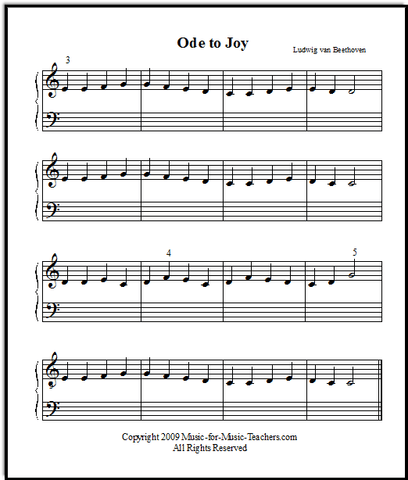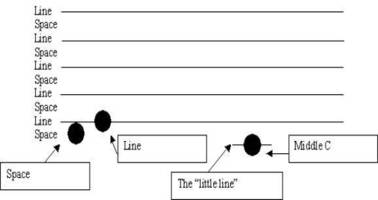Reading Music for Kids Step-by-Step

Lesson 8: Reading Music For Kids Step-By-Step
Reading music is a battle that must be planned, and you must be willing to change strategy the moment the child goes astray, which is inevitable. By now you can see that our strategy is fun, work, fun, work. Here is a set of learning steps that describe children’s common battle to read music.
Make sure that the child can play songs by number, or color, or whatever way gets them happy with the instrument. Do not start their experience at the piano with reading music.
The Five Lines
The first step is to look at a page of music. Open up a book such as one of the Bastien Series or I CAN READ MUSIC.
Below is a good page. I run my finger along the notes slowly, and kids ring the library bell when I pass a Middle C.


Look at the five horizontal lines. That is the playing field for this game. It has nothing to do with numbers or color. It’s a new game played on a field of five horizontal lines. Play drawing games and let them try to draw five horizontal lines. Let them draw circular "notes" centered on one of the five horizontal lines, or on the space in between lines.
That may be as far as you can go with a little child in one day. Older kids find the five lines obvious and are ready for the next steps. Younger kids may take weeks to be secure with these ideas.
Middle C is the central orientation point for a child at the piano. The more you make a child secure with finding and re-finding it, the greater their confidence. Middle C in the world of the piano exists in two places, in two entirely different languages, one physical (the piano) and one graphic (the page).
Almost all children’s struggles to read music at the piano involve a juggling act between these two skills, which are hard enough separately. We must find Middle C both on the piano and on the page.
I Can Read Music e Book Download
Middle C On The Piano
Middle C is the white key to the left of the group of two black keys closest to the center of the keyboard. We’ve previously found Middle C, and numbered it, and put a little red sticker on Middle C, or number one. The child should be able to remember it from countless previous Middle C Games.
Middle C On The Page

This is the hard part. Now we must return to the five lines on the page, and find Middle C in relation to them. Look at Middle C on any page of a child’s piano book. I help kids to recognize Middle C by pointing out that Middle C is the only note that is on its own “little line.”
Emphasize the concept of the “little line,” because that is a perfect child’s way to distinguish Middle C from any other note in the average children’s piano book.
Point to other notes and play a game of trying to fool them into saying they are Middle C. But they will soon be able to pick out Middle C from a maze of other notes. Wait and make very sure they know where it is. It’s worth another week or two of cementing it in their heads. It’s worth retreating after this and coming back to the “little line” distinction again and again before proceeding further.
Bring The Page And Keyboard Together
Now play a game of showing them a page of music, and have them point to a Middle C on the page with their index finger. Then, the first person (the teacher or the student) to reach down and play Middle C on the piano keyboard wins. If it suits the child, keep score on a Post-It and give yourself ridiculously low scores. Do this a dozen times and vary the game by any means necessary. Then walk away and do something else.
Lines And Spaces
Put Middle C away for a bit, and look at a page of music. The little circles (the “notes”) are either on one of the five lines (the line goes through the middle of the circle) or in one of the spaces in between the five lines.

This is a drawing of a musical staff (the five lines) describing notes as being either on one of the five lines, or in the spaces in between the lines. We’re only concerned with the first three notes: Middle C, the note on the space above it, and the note on the lowest of the five horizontal lines. Confine you initial attempts to finding these three notes.
Identify Lines And Spaces
With that in mind, set out and have the child identify notes. Is that note on the page on a line or a space? You have to do this game, interspersed between the other games, over and over, because until it is mastered, you cannot go further with reading music.
Notice one crucial thing: we have done all of this without reference, except for Middle C, to the piano. Kids have to learn to observe the page and make judgments about it. It is easy to get the knack of this, especially if you don’t have to play anything on the piano. Later we will combine the skills, identifying the notes, and playing them, but for now we must limit the scope to attain security for the child. Better to go slow now than risk confusion and disappointment.
The idea is for each step to be so easy that they cannot but help “drawing the line between them.” Drawing all these minute steps together is called “playing the piano.”
COURSE ONE: TEACHING TOOLS
#2 WHAT A CHILD SHOULD EXPECT FROM PIANO LESSONS
#3 WHAT IS FINGERING AND WHEN DO WE USE IT
#4 PIANO BY NUMBER AND OTHER STARTING METHODS
#6 MINUTE BY MINUTE PIANO LESSON
#7 TOYS AND ACCESSORIES FOR FUN PIANO LESSONS
#8 READING MUSIC FOR KIDS STEP BY STEP
#9 THE DIFFERENCE BETWEEN WORST AND BEST TEACHER
#10 A CHILD’S CLASSICAL MUSIC LISTENING LIST
COURSE TWO: TEACHING BACKGROUND
#11 A SHORT HISTORY OF THE PIANO
#12 A SHORT HISTORY OF PIANO METHODS
#13 A PLEASANT PIANO LESSON ATMOSPHERE
#14 ADVICE TO A YOUNG PIANO TEACHER
#16 A PIANO TEACHER’S EMOTIONS
#17 PACE AND CHILDREN’S PIANO LESSONS
#18 CHILDREN’S PIANO MOTOR SKILLS DEFINED BY AGE
#19 CHILDREN’S PIANO FINGERING OVERVIEW
#20 GUILT IS THE WRONG WAY TO BUY ATTENTION
COURSE THREE: PIANO GAMES
#21 FOURS, A PIANO COUNTING GAME
#24 THE USE OF HUMOR IN PIANO LESSONS
#25 HAPPY OR SAD: EAR TRAINING FOR KIDS
#26 FOLLOW THE LEADER: VISUAL PIANO GAMES




